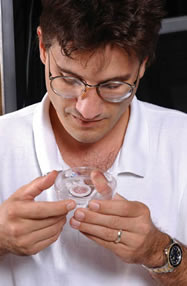|
|
"Brain" In A Dish Acts As Autopilot Living Computerdownloadable pdfA University of Florida scientist has grown a living “brain” that can fly a simulated plane, giving scientists a novel way to observe how brain cells function as a network. The “brain” — a collection of 25,000 living neurons, or nerve cells, taken from a rat’s brain and cultured inside a glass dish — gives scientists a unique real-time window into the brain at the cellular level. By watching the brain cells interact, scientists hope to understand what causes neural disorders such as epilepsy and to determine noninvasive ways to intervene. As living computers, they may someday be used to fly small unmanned airplanes or handle tasks that are dangerous for humans, such as search-and-rescue missions or bomb damage assessments.
“We’re interested in studying how brains compute,” said Thomas DeMarse, the UF assistant professor of biomedical engineering who designed the study. “If you think about your brain, and learning and the memory process, I can ask you questions about when you were 5 years old and you can retrieve information. That’s a tremendous capacity for memory. In fact, you perform fairly simple tasks that you would think a computer would easily be able to accomplish, but in fact it can’t.” While computers are very fast at processing some kinds of information, they can’t approach the flexibility of the human brain, DeMarse said. In particular, brains can easily make certain kinds of computations — such as recognizing an unfamiliar piece of furniture as a table or a lamp — that are very difficult to program into today’s computers. “If we can extract the rules of how these neural networks are doing computations like pattern recognition, we can apply that to create novel computing systems,” he said. DeMarse’s experimental “brain” interacts with an F-22 fighter jet flight simulator through a specially designed plate called a multi-electrode array and a common desktop computer. “It’s essentially a dish with 60 electrodes arranged in a grid at the bottom,” DeMarse said. “Over that we put the living cortical neurons from rats, which rapidly begin to reconnect themselves, forming a living neural network — a brain.” The brain and the simulator establish a two-way connection, similar to how neurons receive and interpret signals from each other to control our bodies. By observing how the nerve cells interact with the simulator, scientists can decode how a neural network establishes connections and begins to compute, DeMarse said. When DeMarse first puts the neurons in the dish, they look like little more than grains of sand sprinkled in water. However, individual neurons soon begin to extend microscopic lines toward each other, making connections that represent neural processes. “You see one extend a process, pull it back, extend it out — and it may do that a couple of times, just sampling who’s next to it, until over time the connectivity starts to establish itself,” he said. “(The brain is) getting its network to the point where it’s a live computation device.” To control the simulated aircraft, the neurons first receive information from the computer about flight conditions: whether the plane is flying straight and level or is tilted to the left or to the right. The neurons then analyze the data and respond by sending signals to the plane’s controls. Those signals alter the flight path and new information is sent to the neurons, creating a feedback system. “Initially when we hook up this brain to a flight simulator, it doesn’t know how to control the aircraft,” DeMarse Although the brain currently is able to control the pitch and roll of the simulated aircraft in weather conditions ranging from blue skies to stormy, hurricane-force winds, the underlying goal is a more fundamental understanding of how neurons interact as a network, DeMarse said. “There’s a lot of data out there that will tell you that the computation that’s going on here isn’t based on just one neuron. The computational property is actually an emergent property of hundreds or thousands of neurons cooperating to produce the amazing processing power of the brain.” With José Principe, a UF distinguished professor of electrical engineering and director of UF’s Computational NeuroEngineering Laboratory, DeMarse has a $500,000 National Science Foundation grant to create a mathematical model that reproduces how the neurons compute. Thomas DeMarse, tdemarse@bme.ufl.edu Carolyn Gramling
|
||

